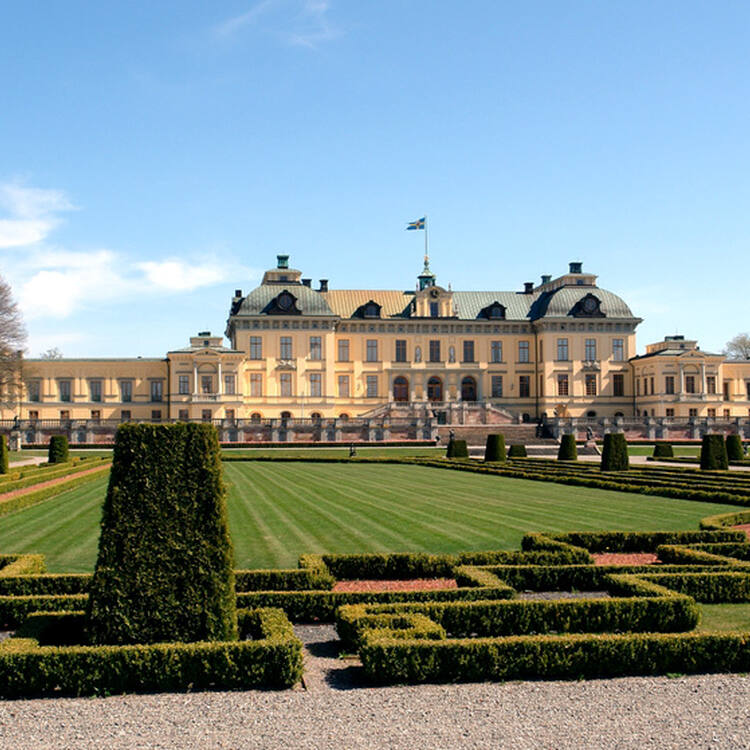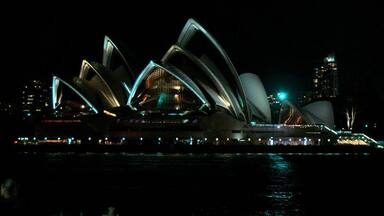Royal Domain of Drottningholm
Royal Domain of Drottningholm
The Royal Domain of Drottningholm stands on an island in Lake Mälar in a suburb of Stockholm. With its castle, perfectly preserved theatre (built in 1766), Chinese pavilion and gardens, it is the finest example of an 18th-century north European royal residence inspired by the Palace of Versailles.
Description is available under license CC-BY-SA IGO 3.0
Domaine royal de Drottningholm
Situé sur une île du lac Mälar dans la banlieue de Stockholm, l'ensemble de Drottningholm, avec son château, son théâtre construit en 1766 et parfaitement préservé, son pavillon chinois et ses jardins, est le meilleur exemple de résidence royale d'Europe du Nord du XVIIIe siècle inspirée par le modèle du château de Versailles.
Description is available under license CC-BY-SA IGO 3.0
قصر دروتنينغهولم الملكي
يقع مجمّع دروتنينغهولم على إحدى جزر بحيرة مالار ويشكّل بقصره ومسرحه العائد الى عام 1766 والذي حافظ تماماً على حالته وجناحه الصيني وحدائقه النموذج الأفضل للمساكن الملكية التي ميّزت اوروبا الشمالية في القرن الثامن عشر والتي شيدت بإيحاء من نموذج قصر فرساي.
source: UNESCO/CPE
Description is available under license CC-BY-SA IGO 3.0
德罗特宁霍尔摩皇宫
德罗特宁霍尔摩皇宫位于斯德哥尔摩地区默拉尔湖的女王岛上,拥有城堡,保存完好的剧场(建于1766年),中国式的庭院楼阁,它还受到凡尔赛宫的影响,成为北欧18世纪皇宫的最佳典范。
source: UNESCO/CPE
Description is available under license CC-BY-SA IGO 3.0
Королевская резиденция Дротнингхольм
Королевская резиденция Дротнингхольм расположена на острове посреди озера Меларен в пригороде Стокгольма. Дворец, прекрасно сохранившийся театр (построенный в 1766 г.), Китайский павильон и парки – это прекрасный пример североевропейской королевской резиденции XVIII в., вдохновленной образцом Версальского дворца.
source: UNESCO/CPE
Description is available under license CC-BY-SA IGO 3.0
Real sitio de Drottningholm
Situado en una isla del lago Mälar, en los alrededores de Estocolmo, el real sitio de Drottningholm, con su palacio, su teatro del año 1766 admirablemente conservado, su pabellón chino y sus jardines, es el ejemplo más espléndido de residencia real de la Europa Septentrional del siglo XVIII inspirada en el modelo del palacio de Versalles.
source: UNESCO/CPE
Description is available under license CC-BY-SA IGO 3.0
ドロットニングホルムの王領地
ストックホルムの西、メーラレン湖のワーベン島にある、ヴェルサイユ宮殿を手本に17世紀に建てられた優美な宮殿で、現国王一家の住まいでもある。宮殿内には劇場、ゴシック様式の塔、当時流行した中国風別荘などがあり、18世紀建築の典型が見られる。なかでも、湖のほとりに広がる庭園に1776年に建てられた宮廷劇場は、200年後の今でも使用できる珍しい劇場である。source: NFUAJ
Koninklijke domein van Drottningholm
Het koninklijke domein van Drottningholm ligt op het eiland Lovön in het Mälar meer, in een buitenwijk van Stockholm. Het Drottningholm ensemble – kasteel, theater, Chinees paviljoen en tuinen – is het beste voorbeeld van een koninklijke residentie gebouwd in de 18e eeuw in Zweden en is representatief voor alle Europese architectuur van die periode. De bouwstijl is beïnvloed door het Château de Versailles. Er woonden verschillende vorsten, die verschillende bouwstijlen. Deze hadden ook invloed op de tuinen. De Franse tuin werd ontworpen naar het voorbeeld van het barokke park van Versailles en de Engelse tuin heeft een meer levendig en pittoresk landschap.
Source: unesco.nl
Outstanding Universal Value
Brief synthesis
The Royal Domain of Drottningholm, situated on the island of Lovön close to Stockholm, is an exceptionally well-preserved ensemble of gardens and buildings with original interior furnishings. It includes Drottningholm Palace, the Palace Theatre, the Chinese Pavilion, Canton Village, the gardens and part of Malmen, and has been used for pleasure and summer recreation from the Baroque era until today. As the current home of the Swedish Royal Family, Drottningholm upholds a cultural continuity with the original purpose of the site.
Drottningholm Palace is representative of 17th and 18th century western and northern European architecture, and the palace grounds were also created during that period. The palace was created with strong references to 17th century Italian and French architecture. The interiors reflect Sweden’s ambitions as one of the most powerful nations of 17th century Europe, from both cultural and political viewpoints. Leading Swedish architects worked together with the best craftspeople in Europe to create a unique ensemble of buildings with rich and lavish interiors.
The Palace Theatre is the only surviving 18th century theatre where the original machinery is still regularly used and the original stage sets are preserved. The sophisticated stage machinery, built by Georg Fröman according to drawings prepared by Christian Gottorp Reuss, is still fully intact, permitting quick changes of scene with the curtain up. A unique collection of stage sets, the dressing rooms, the storerooms, the scenery, and the large auditorium, seating 400 spectators, are preserved. Historical opera productions performed at the theatre are often staged and accompanied by music performed on authentic period instruments by the Drottningholm Theatre Orchestra.
The Chinese Pavilion with its incomparable combination of architecture, interior decoration and collections is preserved and is a symbol of 18th century contacts between Europe and Asia. Together with Canton Village, which includes former buildings for manufacture and living quarters for members of the royal court, this ensemble of buildings gives a comprehensive picture of court life during this era, with touches of influences from distant places.
The gardens were created during different periods and show both continuity and changes in fashion over time. The French formal garden, the rococo garden and the ideal landscape garden are preserved side by side. The French formal garden holds the world’s largest collection of sculptures by Adriaen de Vries.
Malmen is an adjoining 18th century residential area for courtiers and officials of the royal court as well as a site for various palace offices. Malmen was granted a town charter in the late 18th century. The buildings in this area still partly retain their original functions, and their facades are important features of this historical setting.
The surrounding area has been part of the Crown Estate since the 16th century. The character of the landscape is a result of the way it has been used and farmed to support the Crown’s need of supplies and to uphold the King’s household. This continuous use and the way it is and has been managed over the years is still visible in the landscape.
Criterion (iv): The ensemble of Drottningholm is the best example of a royal residence built in the 18th century in Sweden and is representative of all European architecture of that period, heir to the influences exerted by the Chateau of Versailles on the construction of royal residences in western, central and northern Europe.
Integrity
No significant changes have been made to this World Heritage property since the time of inscription. The unique whole that existed then is still present and maintains all the necessary attributes to convey the Outstanding Universal Value of the property. The Drottningholm Palace, the Palace Theatre, the Chinese Pavilion, and the gardens remain intact and represent a royal domain with important elements of 17th and 18th century Swedish and European history.
The Royal Domain of Drottningholm has been an intercultural meeting place for centuries, from the time of its construction by architects and workers of different nationalities to the theatre activities and tourism of today. For centuries, the Drottningholm area has been used for pleasure and summer recreation. Theatre performances and the interest shown by visitors to Drottningholm both maintain this tradition and its function as the home of the Swedish Royal Family.
Authenticity
The historical setting, with the Drottningholm Palace, the Palace Theatre, the Chinese Pavilion, the gardens and the facades of Malmen’s buildings, is intact in form and material from the 17th and 18th centuries. The primary guidelines for this property focus on conservation and not restoration, and on maintaining the original forms, the original materials, and the designed landscape.
Protection and management requirements
The most important Swedish legislation safeguarding the buildings and gardens of this World Heritage property is the Ordinance for State-owned Listed Buildings. The Swedish National Heritage Board, the County Administrative Board of Stockholm and Ekerö Municipality are the national, regional and local authorities responsible for granting permits for alterations to the World Heritage property and for managing the different protection zones. When Drottningholm was inscribed on the World Heritage List the boundaries of the area corresponded with the area it was given as a State-owned Listed Building in 1935. In 2014 the area of the State-owned Listed Building was extended. The current area of the inscribed property is 162.429 ha.
Three main stakeholders operate within the Drottningholm World Heritage property: the National Property Board, the Drottningholm Palace administration and the Drottningholm Palace Theatre. They work together in long-standing continuous cooperation. A management plan for the World Heritage property was adopted in 2007 by these three stakeholders. A buffer zone has been proposed where the boundaries coincide with the Nature reserve at Lovön, which was established at the end of 2015. The area of the Nature reserve will strengthen the level of protection for the area.
Current developments in the infrastructure of Greater Stockholm will affect the Drottningholm area in the future. Road 261 passed through the World Heritage property long before Drottningholm’s nomination, but the traffic situation has changed significantly. Preliminary assessments indicate that adverse impacts, defined as functional, visual and noise disturbances during the construction of the Stockholm Bypass and Ekerö Road extension, are expected to affect to different degrees the attributes of the property, as well as create permanent visual changes in the pastoral landscape when the road is completed. Given these conclusions, all involved parties will aim to limit the negative impacts and work to identify new possibilities and solutions for improved accessibility to the area in conjunction with the developments related to the ongoing Stockholm Bypass and Ekerö Road extension project.
The parties will also consider the Heritage Impact Assessment which has been done in connection with the infrastructure projects. The recommendations and the results of this assessment will assist in identifying potential courses of action to maintain the attributes of the property, its authenticity, and its integrity.
 View photos from OUR PLACE the World Heritage collection
View photos from OUR PLACE the World Heritage collection
